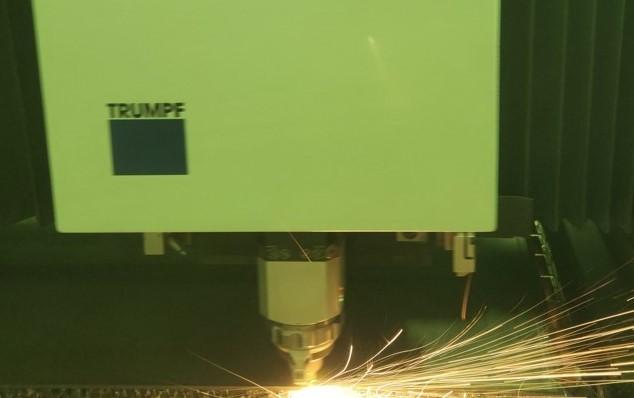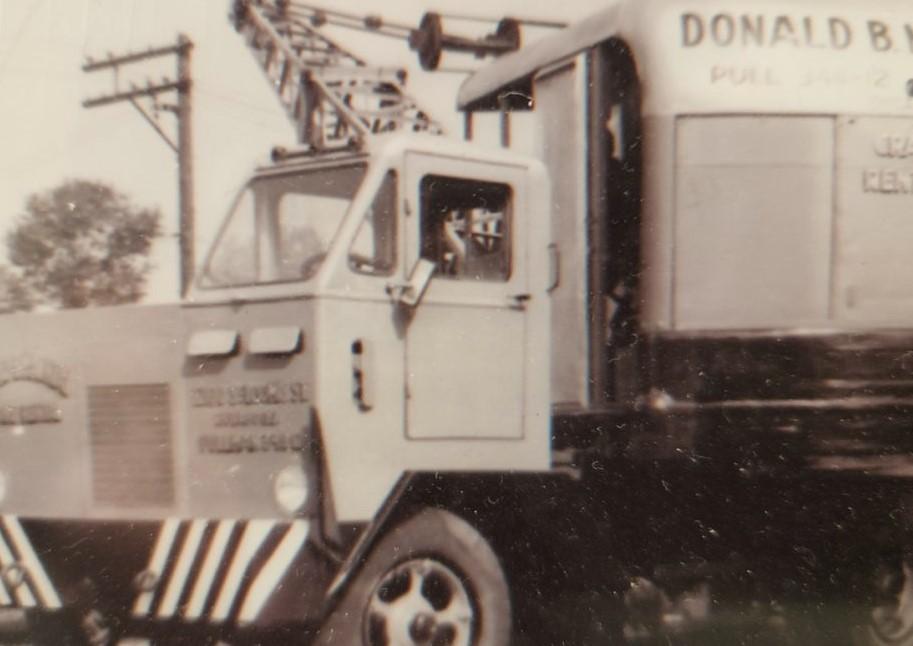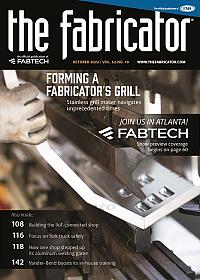Senior Editor
- FMA
- The Fabricator
- FABTECH
- Canadian Metalworking
Categories
- Additive Manufacturing
- Aluminum Welding
- Arc Welding
- Assembly and Joining
- Automation and Robotics
- Bending and Forming
- Consumables
- Cutting and Weld Prep
- Electric Vehicles
- En Español
- Finishing
- Hydroforming
- Laser Cutting
- Laser Welding
- Machining
- Manufacturing Software
- Materials Handling
- Metals/Materials
- Oxyfuel Cutting
- Plasma Cutting
- Power Tools
- Punching and Other Holemaking
- Roll Forming
- Safety
- Sawing
- Shearing
- Shop Management
- Testing and Measuring
- Tube and Pipe Fabrication
- Tube and Pipe Production
- Waterjet Cutting
Industry Directory
Webcasts
Podcasts
FAB 40
Advertise
Subscribe
Account Login
Search
Taking aluminum welding to the next level
Effort culminates a century of evolution at CMC of Georgia
- By Tim Heston
- October 16, 2022
- Article
- Aluminum Welding
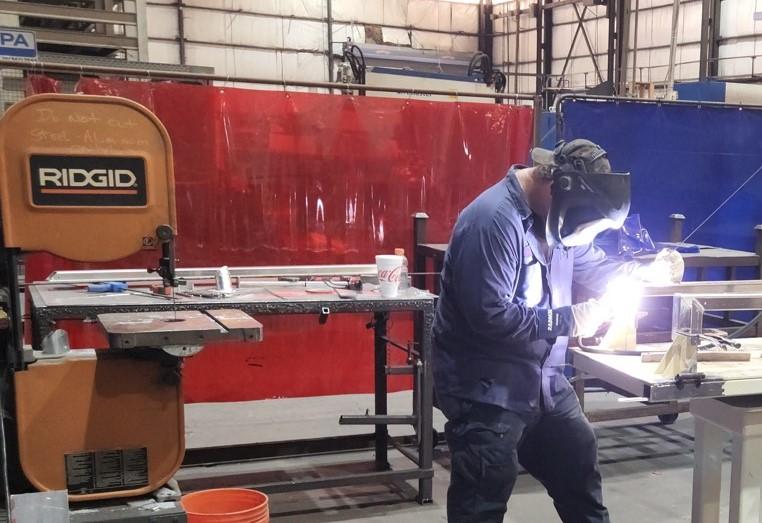
A welder uses gas tungsten arc welding on an aluminum frame. An automated storage and retrieval system, in the background, feeds sheet and plate stock to laser cutting. Pieces move on to bending, then to the rest of the operation.
A framed collage hangs on the wall near a desk occupied by Matt Marty, president of CMC of Georgia and grandson of the company founder. The fabricator has been in business for more than a century, and the collage shows the company’s handiwork over the years. One image shows a custom-fabricated cab for a 1940s-era crane. At that point, the fabricator had already been in business for more than 30 years.
Today, the 60-employee company fabricates a variety of work, including parts for commercial mowers (think golf courses and sod farms) as well as packaging equipment and specialty parts for the oil fields. That said, custom cabs still make up a significant portion of CMC’s revenue.
“We fit in the lower-volume end of the custom-cab business,” Marty said, adding that its bread-and-butter orders involve five to eight cabs a month. Next time you board a plane, check out the vehicles—for fuel, baggage handling, de-icing, and other special purposes—zipping around the tarmac. There’s a good chance some of the cabs on those vehicles came from CMC. Other cabs go to vehicles made for railroad maintenance yards, specialty fork trucks, mining, security, and construction.
CMC’s niche is in niche equipment. The specialty vehicles the company made in the 1940s and 1950s took a lot of planning, very much like the products in the fabricator’s current mix of work. But the way products are now fabricated—with blanking automation, streamlined forming, and some incredibly detailed process planning in welding—likely would have set the company founder’s head spinning.
Early Automobiles to 3D CAD
When Marty’s grandfather launched Chicago Manufacturing Co. (CMC) in 1910, the city had more horses than cars. During the shop’s initial decades, employees fabricated in-car water heaters (bleeding edge tech of the early 1900s). By the mid-1950s, the company was already an established player in the specialty vehicle cab market.
As a youth, Marty recalled watching sheet metal craftsmen laying out cut lines, shearing pieces to size, punching with a single-station punch, then forming on a mechanical brake. “They could do a lot of radius work too,” Marty recalled, adding that the shop produced a plethora of complicated contours and cones, all documented in an unusual way.
“All the engineering prints were drawn full size, done on large tables in the office” Marty said. These weren’t typical blueprints with isometric views. “All three views were on top of each other, drawn in different colors on the same piece of paper.”
Marty shook his head and chuckled. “They were so hard to read, and I never quite got them,” he said, adding that those who worked with them could of course comprehend them. For those who learned how to read them, the drawings gave a complete view of what could be a very complex job—perhaps a harbinger of some of the extensive fabrications the company’s employees work with today.
Those unique, real-size prints aren’t being used today, of course. Over the decades, CMC adopted design software like ProE and SolidWorks. Today, the company uses TruTops for its TRUMPF blanking systems and press brakes, simulating brake programs offline. The company’s OTC DAIHEN welding power sources can store 100 separate weld settings, tailoring voltages and amperages for various jobs. CMC has embraced the digitization of metal fabrication, from blanking to welding, but the heart of the operation still resides in welding and assembly, where complex fabrications require extraordinary attention to detail.
Welding Engineer Jason Smith, a certified welding inspector and educator (CWI/CWE), was hired in September 2021 to step up CMC’s aluminum welding game. He pointed to an aluminum blank dotted with etchings, made by the company’s 8-kW solid-state TRUMPF laser it installed in 2021. Those blanks were to become the fabricated “skins” of specialty cabs for railway maintenance vehicles. It was to be sent to a company in the Southeast, which in turn will send them to an end customer in Europe.
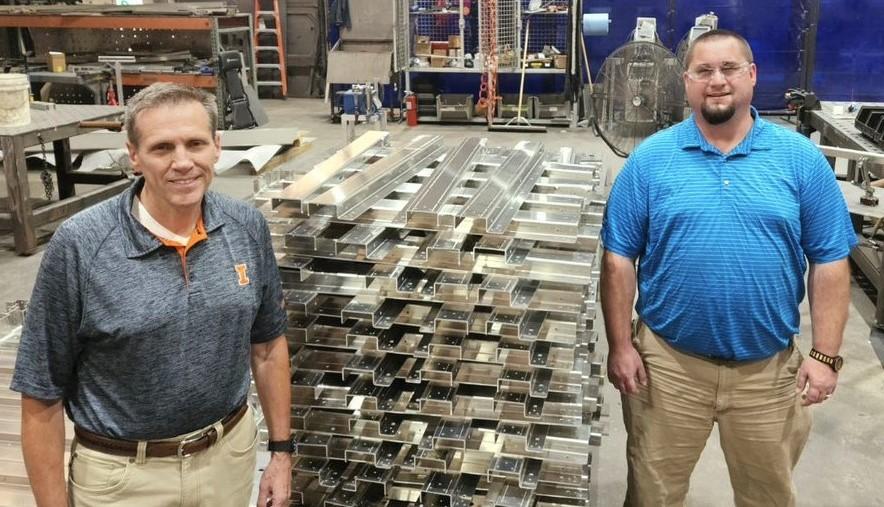
(From left) Matt Marty, president, and Jason Smith, welding engineer, have been leading CMC’s effort to ramp up the operations’ aluminum fabricating and welding capability. The shop now is certified to EN 15085-2, a European standard for welding railway vehicles and components.
“If we had to lay all that out by hand,” Smith said, pointing to those laser-etched weld locations, “it would have been a nightmare.”
Move to Georgia, Automation
In 1981, CMC opened a facility in Winder, Ga., northwest of Atlanta. Six years later, CMC closed its Chicago office and moved everything down to the Georgia location.
Marty’s father died in 1989, after which Marty took over the business, now known as CMC of Georgia. In 2007, the shop moved to a plant in Toccoa, a small town near the far northeast corner of the state. The move was strategic for several reasons. First, though the region is picturesque, in the middle of the North Georgia mountains, it also has a long history of manufacturing. The 115,000-sq.ft. plant CMC moved into was previously occupied by a refuse equipment manufacturer. Second, the plant gave CMC the open layout and overhead crane space it needed to ramp up its fabrication capabilities. Workers in the Winder facility spent too long waiting for large fabrications to be moved from one station to another. Today, work follows a simple flow pattern, with raw material entering on the far end of the plant and finished products staged for shipping on the near end, next to the office. Four 20-ton cranes and 18 jib cranes help everyone keep work on the move.
Also in 2007, CMC invested in its STOPA automated storage and retrieval system, which fed two TRUMPF lasers. “We didn’t want our material stored all over the place,” Marty said, “not knowing what we had and not being able to cut ahead. We can cut and store parts in the STOPA, and we can pull those as we need them.”
The company’s use of the technology has evolved in recent years, especially after investing in the 8-kW solid-state laser. The new machine has so much capacity, the company no longer needs to run the laser overnight, and cutting ahead isn’t as critical as it used to be. Live inventory remains the system’s greatest benefit; with a few mouse clicks, the shop can see what material it has and what it should order.
The Supply Chain Roller Coaster
Walking the shop floor, Marty pointed to some of the extra work in process (WIP), telltale signs of supply chain issues that all too many fabricators have experienced over the past few years. CMC hasn’t had problems getting raw material, but getting some purchased components and supplies have been a challenge.
The most significant challenges, though, have come from delayed orders. CMC starts a fabrication, then puts on the brakes as they learn other companies in the supply chain can’t get the parts they need. That said, Marty isn’t looking to reduce WIP, at least at this juncture, because it’s allowing the shop to respond quickly when customers give the green light to ship.
“We’re looking to keep customers happy, which is why we’re carrying more inventory,” Marty explained. He said this while pointing to raw stock racks near the STOPA system. To ensure it can respond to customer demand, CMC is carrying more raw stock too.
The STOPA delivers cut blanks to an offload table adjacent to the forming department, which includes two TRUMPF press brakes complete with sheet followers and large open heights to account for large flanges. Many parts emerge from blanking not only with etched weld locations but also etched part identification.
Look downstream in welding, painting, and assembly, and it’s easy to see why part identification is so important. CMC does fabricate piece-parts and subassemblies, but the lion’s share of its revenue comes from large assemblies involving hundreds of components and (literally) thousands of weld locations.
New Focus on Aluminum Welding
Back in the front office conference room, Welding Engineer Jason Smith points to a stack of papers, flipping to a page that includes hundreds of callouts for aluminum weld studs. And that’s just one page in the middle of a thick stack. “This product is a CPC2, which requires 100% visual inspection. Every single weld has to be visually inspected, and there are literally thousands of welds.”
CPC2 refers to a job classification that dictates nondestructive examination (NDE) requirements as described in EN 15085-3, a European standard for welding railway vehicles and components.
Since joining CMC last year, Smith helped the company achieve certification to the EN 15085 standard—a rare feat among North American fabricators. The standard takes welder continuity requirements to the next level. For instance, to start a new job fabricated to the EN standard, a welder must take a test to prove that he or she can perform the specific weld requirements for the job at hand. “To maintain their welder qualification, they must perform a test applicable to that welder qualification every six months,” Smith said. “Then, every two years, they must redo the original weld test to renew the welder qualification.
“If a job requires a GMAW-P butt weld, then the welder has to perform a weld, have it visually tested, radiographically tested, fracture tested, and have a bend test at the end,” Smith continued. “If it’s a fillet weld, you do a fillet-weld break test and cut samples off of that for macro-etching.” He added that weld test requirements vary depending on job requirements, but all of them ensure that “welders are held accountable for their technique and ability.”
Welding procedures are extremely detailed. Instead of specifying ranges for, say, acceptable travel speeds, volts, and amperages, Smith runs a calculation (as specified in the EN standard) for every weld type, including process choice (like pulsed gas metal arc welding, GMAW-P, or gas tungsten arc welding, GTAW), voltage, amperage, and travel speed.
Today, Smith wears a variety of hats, and one of them is teacher. “Training is in my backbone,” he said. (Smith spent several years as a welding instructor at North Georgia Technical College.) Throughout the day, Smith works with welders, observing and improving their technique, which has become ever more critical as welds become more challenging.
Smith pointed to one job involving a 6061-T6 aluminum, 2-in.-dia. square tube with a 0.25-in. wall being welded to 0.080-in., 5052-H32 aluminum skin. Using GMAW-P, the welder laid down a stringer bead in the vertical-up orientation—all without a hint of burning through. The setup does incorporate a stainless steel backing plate, used for a heat sink, but a lot of the success hinges on welder technique. The welder’s travel speed must be extremely consistent along with the stickout, gun angle, and standoff—not an easy feat welding vertical-up. Even a minute weave could push heat beyond acceptable limits, and the welder would end up melting through.
Besides training, Smith acts as communication coordinator, particularly for some of the company’s more complicated assemblies, helping interpret drawings and walking personnel through 3D-CAD representations, now available on computer workstations on the floor.
All this bleeds into yet another role Smith plays: finding efficiencies to shorten overall fabrication time—especially for jobs certified to the EN railway standard. That standard requires aluminum material to be certified and separated; “aluminum only” signs can be found on various pieces of equipment throughout the plant. Also, quality control personnel must inspect and sign off at various stages of fabrication, a factor that governs batch sizes that flow from cutting and bending.
Previously, the shop had “drip fed” parts to quality control (QC) as they were finished. After all, it had the flexible cutting and bending equipment that allowed for quick changeover, and smaller batch sizes meant better flow, right? Not necessarily, especially when factoring in QC resources. For EN work, quality personnel need to verify each piece is cut and bent to within tolerance. This includes part-specific tolerances as well as tolerances that affect “parent-child” part relationships in larger assemblies.
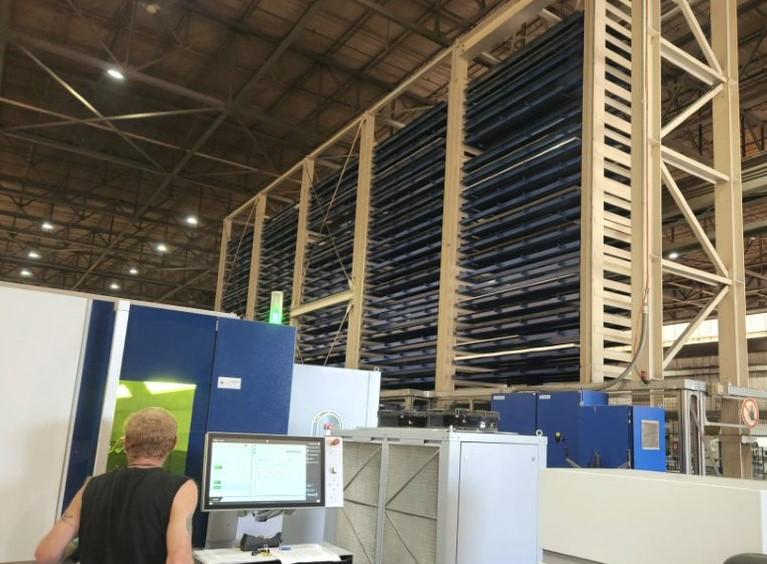
A laser operator monitors the 8-kW cutting system situated next to the company’s STOPA automated storage and retrieval system.
“Now, all the material needed [for an assembly] is cut and ready prior to fabrication, so there’s no lag time [at QC],” Smith said, adding that this alone helped cut several weeks out of production for certain railway cab products.
A Niche for the Future
Marty walked by the STOPA system and looked up at the towers. “Yeah, we had bad timing on that one,” thinking back to the business climate between 2007 and 2009. The shop installed the system in 2007 and experienced moderate growth in 2008 before the bottom dropped out in 2009. “We were doing really well through October of 2008, but then in 2009, everything shut down.”
Marty added, however, that he has no regrets about the investment. The company had the cash to get through the Great Recession, and the automation helped the company rebuild business quickly during the ensuing years.
The same held true with the pandemic recession of 2020. “We saw the airline industry just come to a stop,” he said. “So, all the customers that build air/ground transport equipment stopped as well.” But like it always has at CMC, business eventually returned, and lack of demand is no longer a problem.
The challenge now is about the supply chain. Still, like before, CMC hasn’t stopped moving forward. To protect customers, it’s holding more inventory. And the current challenge hasn’t stopped its continued investment in aluminum welding. It’s also hoping to gain ISO 9001 certification by year-end.
“Our business has gotten a lot more complex over the past year,” Marty said, referring to CMC’s ramp-up of aluminum welding. “That’s going to be a good thing for us.” He added that successfully tackling such complexity will give CMC a competitive edge, and therein lies opportunity.
About the Author

Tim Heston
2135 Point Blvd
Elgin, IL 60123
815-381-1314
Tim Heston, The Fabricator's senior editor, has covered the metal fabrication industry since 1998, starting his career at the American Welding Society's Welding Journal. Since then he has covered the full range of metal fabrication processes, from stamping, bending, and cutting to grinding and polishing. He joined The Fabricator's staff in October 2007.
subscribe now

The Fabricator is North America's leading magazine for the metal forming and fabricating industry. The magazine delivers the news, technical articles, and case histories that enable fabricators to do their jobs more efficiently. The Fabricator has served the industry since 1970.
start your free subscription- Stay connected from anywhere

Easily access valuable industry resources now with full access to the digital edition of The Fabricator.

Easily access valuable industry resources now with full access to the digital edition of The Welder.

Easily access valuable industry resources now with full access to the digital edition of The Tube and Pipe Journal.
- Podcasting
- Podcast:
- The Fabricator Podcast
- Published:
- 04/16/2024
- Running Time:
- 63:29
In this episode of The Fabricator Podcast, Caleb Chamberlain, co-founder and CEO of OSH Cut, discusses his company’s...
- Industry Events
16th Annual Safety Conference
- April 30 - May 1, 2024
- Elgin,
Pipe and Tube Conference
- May 21 - 22, 2024
- Omaha, NE
World-Class Roll Forming Workshop
- June 5 - 6, 2024
- Louisville, KY
Advanced Laser Application Workshop
- June 25 - 27, 2024
- Novi, MI
























